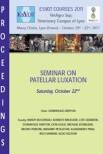Objective: The main aim of this study was to compare the biomechanical properties of caudal cervical vertebral stabilization using bicortical transpedicular pins with polymethylmethacrylate (PMMA) versus transvertebral body polyaxial screws and connecting rods with or without an interbody distractor.
Study design: Ten canine cervical vertebral columns (C2-T3) were used. Four models (intact, transvertebral body polyaxial screw with interbody distractor [polyaxial + distractor], transvertebral body polyaxial screw without interbody distractor [polyaxial - distractor] and bicortical transpedicular pins/polymethylmethacrylate [pin-PMMA]) were applied to C6-7 sequentially on the same specimens. Angular range of motion (AROM) in the form of flexion and extension was measured at C4-5, C5-6 and C6-7 in all groups.
Results: Treated vertebral specimens had significantly less AROM than unaltered specimens. There was no significant difference in AROM between the experimental groups at C6 and C7. Angular range of motion ratio in flexion-extension was 80.8, 72.7 and 78.3% for polyaxial + distractor, polyaxial - distractor and pin-PMMA groups, respectively, which were less than the intact group. There was no significant increase in the range of motion of the adjacent vertebrae after stabilization.
Conclusion: Stabilization obtained with transvertebral body polyaxial screws was comparable to that from the well-established bicortical pins/PMMA construct. Association of an intervertebral distractor did not change AROM of the polyaxial screw constructs.









